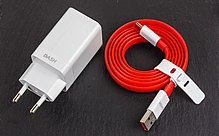VOOC
VOOC , which stands for English Voltage Open-loop multi-step constant-current charging is a proprietary transmission method of electrical power on the USB interface . It is used to quickly charge mobile devices such as specially designed smartphones . The interface was developed by Oppo Electronics in 2014 and is used under various trade names such as Dash Charge by companies such as OnePlus . VOOC is a competitor interface to Qualcomm's proprietary Quick Charge USB charging interface .
technology
VOOC requires special chargers, a special USB charging cable and mobile devices designed for VOOC. If either the charger, the USB charging cable or the mobile device is not VOOC-capable, the USB interface on the power supply unit behaves like a standardized USB charging connection and can charge any USB device with a low charging power. The VOOC power supply unit can provide more power to a VOOC-capable mobile device via a VOOC USB charging cable, which enables the battery to be charged more quickly. For example, with VOOC the battery of the OnePlus 3 or OnePlus 5 can be charged to 63% in 30 minutes.
Since the electrical voltage to conventional USB 2.0 ports to 5 V is fixed and the plug contacts of the USB connector used in the current carrying capacity of 2 A are limited, the maximum transmittable power is set to 10 W restricted. The VOOC interface uses two contacts connected in parallel for the power supply in order to be able to transmit a higher current of maximum 4 A. With VOOC, the mobile device with the VOOC-capable charger identifies itself as a VOOC-capable device via the USB data interface, whereupon the VOOC charger goes into VOOC mode and increases its output current. In contrast to other methods such as Qualcomm's Quick Charge, the voltage of 5 V at the USB port is not fixed, but the current value is set to higher values such as 4 A - the voltage is then set in a certain range.
The constant current allows for simpler charging electronics in the mobile device and thus reduces the power loss in the mobile device - the power loss in the plug-in power supply is increased, but can be dissipated there more easily. This means that the charge controller in the mobile device with VOOC has a higher power available for fast charging.
Individual evidence
- ↑ Archived copy . Archived from the original on April 2, 2015. Retrieved March 27, 2015.
- ^ Never Settle. Retrieved August 26, 2018 .
- ↑ Dash Charge: This is what the new fast charging technology from OnePlus is all about | EURONICS trend blog . In: EURONICS trend blog . June 27, 2016 ( euronics.de [accessed August 26, 2018]).
- ↑ Quick Charge, Dash Charge, VOOC and Co .: Fast charging technologies in comparison. Retrieved September 2, 2017 .
- ↑ Dash Charge vs. Quick Charge: OnePlus 3 charges significantly faster than the Galaxy S7 . In: GIGA . August 10, 2016 ( giga.de [accessed August 26, 2018]).
